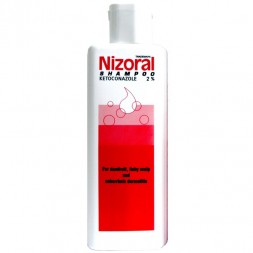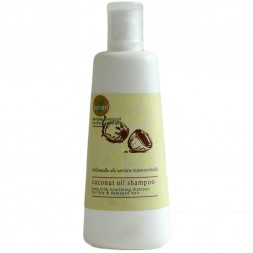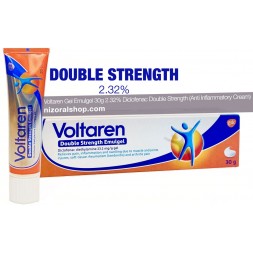Ever wonder why the sides of your nose and forehead are so red and flaky? It is possible you may just suffer from Seborrheic Dermatitis. Learn what causes this fungal infection and find out how to treat Seborrheic Eczema.
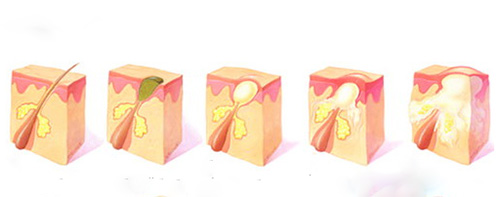
Illustration of how sebum can lead to hair loss.
What is Seborrheic Dermatitis?
Seborrheic Dermatitis is a chronic skin inflammation that overproduces sebum from the sebaceous glands, usually affecting the scalp, face and back. Another medical term used is Seborrhea. It comes the Latin Sebum and means production of oil or “grease”-like substance, while rrhea (from Seborrhea) refers to a discharge of liquid. Seborrheic Dermatitis is also called sebopsoriasis, seborrheic eczema, dandruff and pityriasis capitis.
What causes Seborrheic Dermatitis?
One of the reasons that cause Seborrheic Dermatitis or Seborrheic Eczema is a low immune system defense. Sometimes, your body can be weak and, therefore, are not strong enough to protect itself against infection, especially if levels of B2, B6 vitamins and biotin are low (learn more about how to get a strong immune system).
Seborrheic Dermatitis happens due to a production overdrive of the sebaceous glands. In other words, your body produces oil to make sure the skin and scalp stay hydrated and lubricated. However, aggressive skin products and/or washing your face, scalp or back too much exacerbate the situation, as removing the skin oily layer encourages your sebaceous glands to produce even more sebum. Two facial washes per daily is the general recommendation limit.
Another reason why Seborrheic Eczema occurs may be due to fungal infection called Malassezia Globosa. It’s a natural fungus that our body produces. Some people are more sensitive to it and it leads the yeast to discharge toxic substances irritating and inflaming the skin as a reaction.
Stress, Anxiety and Fatigue are known factors that can stimulate and inflame the skin causing sebum overproduction.
How Do You Know You Have Seborrheic Dermatitis (Seborrheic Eczema)?
Seborrheic Dermatitis symptoms include itchy flaky scalp that may develop as a first sign. It is also common to experience Seborrheic Dermatitis on the skin of the face, particularly around the sides of nose and eyebrow areas, as redness and white or yellow flakes may occur. Yellowish to red scaly pimples may also occur behind and/or inside the ears and on the torso area. Note that hair loss can be a sign of Seborrheic Dermatitis.
Baby Seborrheic Eczema in infants not older than three months may produce excessive and thick discharge of oil that may lead to cracked skin also known as cradle cap on the scalp and around the hairline area.
See Seborrheic Dermatitis pictures below as symptom checker examples.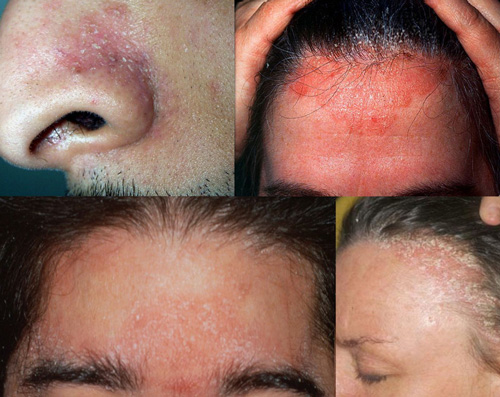
Four different signs you may have Seborrheic Dermatitis.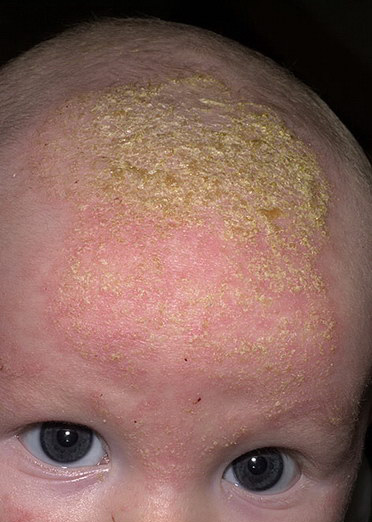
An example of Yellow crust (cradle cap) in baby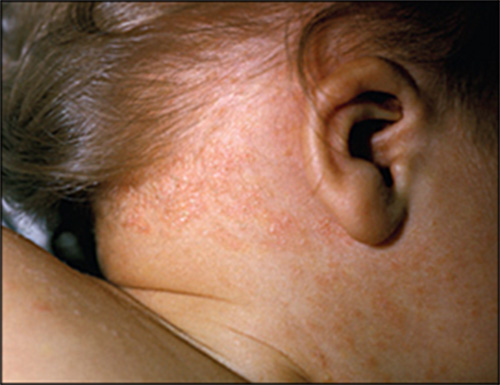
Infant with Seborrheic Eczema around the ear and on the back of the neck and scalp.
How To Get Rid Of Seborrheic Dermatitis?
There are some natural ways you can treat Seborrheic Dermatitis. If symptoms occur on the face, hydrating the skin with a mild organic facial moisturizer can help reduce the signs, especially in winter and/or dry conditions, as the skin is more sensitive to cold and dry weather. Another natural solution to treat Seborrheic Eczema is to use Melaleuca Oil, which is an essential tea tree oil from Australia. The essential oil may be applied directly to the skin and scalp gently massaging into the area. Some users report, however, side effects such as skin irritation and swelling using Melaleuca Oil.
Ketoconazole Cream (read more) is a convincing Seborrheic Dermatitis treatment for face and skin, as it is an antifungal topical solution that kills yeast infection, including Malassezia Globosa. A similar Ketoconazole Shampoo can be also used for scalp Seborrheic Dermatitis. Nizoral Cream and Nizoral Shampoo are often recommended as both contain 2% Ketoconazole.
Check out our last news: Ear Psoriasis
Related article that may interest you: How To Prevent Dandruff?
Always seek the advice of your physician or other qualified health provider with any questions you may have regarding a medical condition. The material appearing on this page is for informational use only. It should not be used as a substitute for professional medical advice, diagnosis or treatment.

